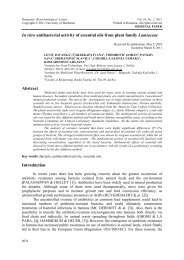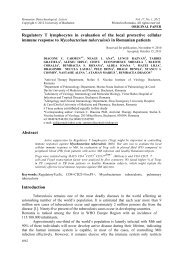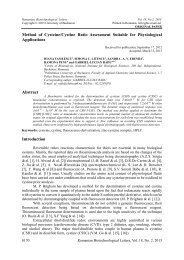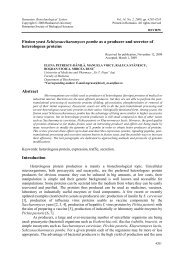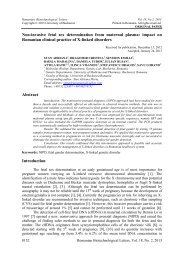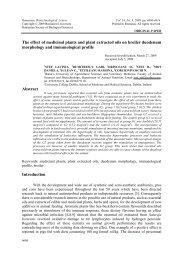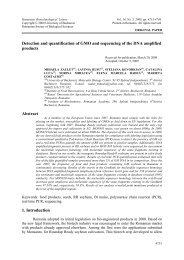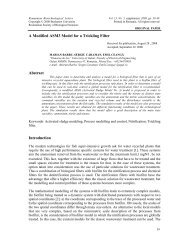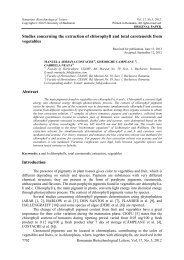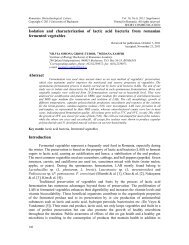Recent advances in oat-based functional cereal products Abstract ...
Recent advances in oat-based functional cereal products Abstract ...
Recent advances in oat-based functional cereal products Abstract ...
Create successful ePaper yourself
Turn your PDF publications into a flip-book with our unique Google optimized e-Paper software.
Romanian Biotechnological Letters Vol. 17, No.6, 2012<br />
Copyright © 2012 University of Bucharest Pr<strong>in</strong>ted <strong>in</strong> Romania. All rights reserved<br />
REVIEW<br />
<strong>Recent</strong> <strong>advances</strong> <strong>in</strong> <strong>oat</strong>-<strong>based</strong> <strong>functional</strong> <strong>cereal</strong> <strong>products</strong><br />
<strong>Abstract</strong><br />
Received for publication, October 15, 2012<br />
Accepted, December 5, 2012<br />
ALEXANDRA POPA (JURCOANE) * , DENISA DUŢĂ ** , PETRU NICULIŢĂ *<br />
* UASVM Bucharest, 59 Marasti Blvd., Bucharest 1, Romania<br />
Correspond<strong>in</strong>g author: Alexandra Popa (Jurcoane)<br />
Tel. 0744138873, e-mail: alexandra.jurcoane@gmail.com<br />
** National Institute of Research&Development for Food Bioresources - IBA Bucharest,<br />
6 D<strong>in</strong>u V<strong>in</strong>tila Str., 021102, Bucharest 2, Romania<br />
This paper is a product of a doctoral thesis on develop<strong>in</strong>g <strong>oat</strong>-<strong>based</strong> <strong>functional</strong> <strong>products</strong> <strong>in</strong><br />
correlation with consumer perception of health risks, funded by POSDRU project 107/1.5/S/76888. The<br />
analysis of the recent literature revealed a massive <strong>in</strong>terest <strong>in</strong> <strong>oat</strong>-<strong>based</strong> <strong>functional</strong> <strong>products</strong> and that<br />
technological improvements were made to develop more such <strong>products</strong>. Oat proved to be a valuable<br />
<strong>in</strong>gredient that could improve considerably the nutritious value of <strong>cereal</strong> <strong>products</strong> like bread, pasta,<br />
noodles or cakes and, more specifically, gluten-free <strong>products</strong>. The ma<strong>in</strong> technological improvements<br />
<strong>in</strong>vestigated were the utilization of process optimization <strong>in</strong> terms of water and gluten addition, use of high<br />
hydrostatic pressure, enzyme treatment, sourdough addition, endogenous enzyme <strong>in</strong>activation and,<br />
specifically for gluten-free <strong>products</strong>, replacement of α-gliad<strong>in</strong>s with <strong>oat</strong> aven<strong>in</strong>s. <strong>Recent</strong> studies also<br />
showed extrusion to be an advantageous method to produce <strong>oat</strong>-<strong>based</strong> <strong>products</strong>. New health benefits of<br />
<strong>oat</strong>s with health claim potential were identified, like antioxidant capacity, reduction of atherogenesis, and<br />
hypoglycaemic and <strong>in</strong>hibitory effects on <strong>in</strong>test<strong>in</strong>al dissaccharidases. Moreover, the literature highlighted<br />
the importance of consumer acceptance and appeal <strong>in</strong> order to <strong>in</strong>clude <strong>oat</strong>-<strong>based</strong> <strong>functional</strong> food <strong>in</strong> their<br />
daily diets so to reach the necessary <strong>in</strong>take levels to get the currently claimed health effects.<br />
Key words: <strong>functional</strong> food, <strong>oat</strong>, gluten-free, bread, β-glucan, dietary fibre enrichment<br />
Introduction<br />
Oat (Avena sativa) is an under-utilised gra<strong>in</strong> <strong>in</strong> human nutrition, yet it is a good source<br />
of dietary fibre, especially β-glucan, essential am<strong>in</strong>o-acids, unsaturated fatty acids, vitam<strong>in</strong>s,<br />
m<strong>in</strong>erals and antioxidants (E.K. HÜTTNER & E.K. ARENDT [1]). Oat bran <strong>in</strong> particular is a<br />
good source of B complex vitam<strong>in</strong>s, prote<strong>in</strong>, fat, m<strong>in</strong>erals and β-glucan. The β-glucan has<br />
outstand<strong>in</strong>g <strong>functional</strong> properties and is of immense importance <strong>in</strong> human nutrition. Different<br />
physiological effects of β-glucan are related to its viscosity, attenuation of post-prandial<br />
plasma glucose and <strong>in</strong>sul<strong>in</strong> responses, high transport of bile acids towards lower parts of the<br />
<strong>in</strong>test<strong>in</strong>al tract and high excretion of bile acids thereby lower<strong>in</strong>g of serum cholesterol levels<br />
(M.S. BUTT & al. [2]). Moreover, <strong>oat</strong> is also suitable for most coeliac patients and helps<br />
them enrich and diversify their diet, by hav<strong>in</strong>g a higher nutritious value than conventional<br />
gluten-free <strong>in</strong>gredients (E.K. HÜTTNER & E.K. ARENDT [1]).<br />
The European Food Safety Authority (EFSA [3], [4], [5]) has approved the follow<strong>in</strong>g<br />
health claims for <strong>oat</strong>s: ‘Regular consumption of β-glucans contributes to ma<strong>in</strong>tenance of<br />
normal blood cholesterol concentrations’; ‘Consumption of β-glucans from <strong>oat</strong>s or barley<br />
contributes to the reduction of the glucose rise after a meal’; ‘Oat gra<strong>in</strong> fibre contributes to an<br />
<strong>in</strong>crease <strong>in</strong> faecal bulk’; ‘Oat β-glucan has been shown to lower/reduce blood cholesterol.<br />
Blood cholesterol lower<strong>in</strong>g may reduce the risk of (coronary) heart disease’. Also, the Food<br />
and Drug Adm<strong>in</strong>istration (FDA) recognized s<strong>in</strong>ce 1997 the efficacy of <strong>oat</strong> β-glucan <strong>in</strong><br />
7717
ALEXANDRA POPA (JURCOANE), DENISA DU Ă, PETRU NICULI Ă<br />
reduc<strong>in</strong>g the risk of coronary heart disease (E.K. HÜTTNER & E.K. ARENDT [1]).<br />
However, <strong>in</strong> order to obta<strong>in</strong> the cholesterol claimed effects, at least 3 g of β-glucans from <strong>oat</strong>s<br />
per day or 0.75 g per portion should be consumed, while for the reduction of post-prandial<br />
glycaemic responses, the <strong>in</strong>take of 4 g of β-glucans for each 30 g of available carbohydrate<br />
per meal is needed accord<strong>in</strong>g to FDA and EFSA recommendations.<br />
Additional <strong>oat</strong> benefits that were recently researched on mice are the hypoglycaemic<br />
effects and <strong>in</strong>hibitory effect on <strong>in</strong>test<strong>in</strong>al disaccharidases of <strong>oat</strong> β-glucan (J. DONG & al. [6]),<br />
and the reduction of atherogenesis (K.E. ANDERSSON & al. [7]). In S. RAGAEE & al. [8],<br />
it is highlighted that the outer layer and germ of <strong>oat</strong> gra<strong>in</strong> represent a rich source of bioactive<br />
components (e.g. dietary fibres, antioxidants, phenolics, lign<strong>in</strong>, vitam<strong>in</strong>s, m<strong>in</strong>erals) l<strong>in</strong>ked to<br />
the reduced risk of cardiovascular disease, cancer, diabetes, obesity and coronary heart<br />
disease. S. ZILIC & al. [9] observed a high content of lipid soluble antioxidants (tocopherols,<br />
yellow pigments) and phenolics (polyv<strong>in</strong>ylpolypyrrolidone bound phenolics, ferulic acid) <strong>in</strong><br />
hulless <strong>oat</strong> (Avena nuda), represent<strong>in</strong>g an important source for the development of <strong>functional</strong><br />
foods. L. RYAN & al. [10] also found that consumption of <strong>oat</strong>-<strong>based</strong> breakfast <strong>cereal</strong>s <strong>in</strong><br />
general could be a significant contributor to the total polyphenol content and antioxidant<br />
potential of the diet.<br />
This paper reviews recent refereed published literature particularly associated with the<br />
opportunities presented by <strong>oat</strong> as a <strong>functional</strong> <strong>in</strong>gredient <strong>in</strong> <strong>cereal</strong> <strong>products</strong>. By review<strong>in</strong>g the<br />
available literature, possible approaches for the food <strong>in</strong>dustry and topics for further research<br />
are identified.<br />
Methodology for the review<br />
The search strategy for the present review sought recent published scientific work<br />
associated with <strong>oat</strong>s’ potential as <strong>functional</strong> <strong>in</strong>gredient, with a focus on <strong>functional</strong> bread, <strong>in</strong><br />
the English language. The search was conducted <strong>in</strong> September-October 2012, on the onl<strong>in</strong>e<br />
database Science Direct, look<strong>in</strong>g for references dat<strong>in</strong>g from 2010 onwards, us<strong>in</strong>g the terms<br />
“<strong>oat</strong> <strong>functional</strong> <strong>in</strong>gredient”.<br />
A further search was conducted of the terms “<strong>oat</strong> <strong>functional</strong> bread”, dat<strong>in</strong>g from 2008,<br />
<strong>in</strong> order to further narrow the subject of the present review.<br />
After read<strong>in</strong>g the abstracts of the 61 papers gathered, <strong>in</strong> order to determ<strong>in</strong>e which<br />
paper was relevant, a total of 30 papers were read <strong>in</strong> full and referenced <strong>in</strong> the review. Out of<br />
the total number of refereed articles, four were reviews (M.S. BUTT & al. [2], A.<br />
KTENIOUDAKI & E. GALLAGHER [11], E.K. HÜTTNER & E.K. ARENDT [1], F.<br />
ROBIN & al. [12]).<br />
Any search result that was unrelated to <strong>oat</strong>-<strong>based</strong> <strong>functional</strong> <strong>cereal</strong> <strong>products</strong> was<br />
excluded, ma<strong>in</strong>ly articles on <strong>functional</strong> beverages enriched with β-glucans and articles on βglucan<br />
extraction process.<br />
Limit<strong>in</strong>g the search to refereed papers ensures that conclusions are drawn only from<br />
credible, high quality material that has undergone a process of unbiased evaluation <strong>in</strong>volv<strong>in</strong>g<br />
qualified third party experts with<strong>in</strong> the field.<br />
Current status of <strong>oat</strong> as <strong>functional</strong> <strong>in</strong>gredient <strong>in</strong> mixed <strong>cereal</strong> <strong>products</strong><br />
Oat, among other <strong>cereal</strong>s, is often used to enrich baked and extruded <strong>cereal</strong> <strong>products</strong><br />
with fibre. In their review, A. KTENIOUDAKI & E. GALLAGHER [11] highlighted that<br />
levels of dietary fibre <strong>in</strong> <strong>oat</strong>s have been reported to be between 10.6% <strong>in</strong> naked varieties and<br />
18.5-23.4% <strong>in</strong> hulled varieties, while β-glucan component ranged between 4.5 and 5.6%. The<br />
total dietary fibre of <strong>oat</strong> bran was found to vary between 20.4 and 26.4%.<br />
7718 Romanian Biotechnological Letters, Vol. 17, No. 6, 2012
<strong>Recent</strong> <strong>advances</strong> <strong>in</strong> <strong>oat</strong>-<strong>based</strong> <strong>functional</strong> <strong>cereal</strong> <strong>products</strong><br />
Technological progress is needed to allow higher amounts of <strong>oat</strong>s to be <strong>in</strong>corporated<br />
<strong>in</strong> <strong>cereal</strong> <strong>products</strong> to deliver the expected health benefits and, <strong>in</strong> the same time, to be accepted<br />
by consumers. This is emphasized <strong>in</strong> a study by U. TIWARI & E. CUMMINS [13], where a<br />
β-glucan human exposure assessment model was developed for an <strong>oat</strong> bread, to compare the<br />
result<strong>in</strong>g exposure to the current FDA recommendation. The model highlights that only at the<br />
highest substitution rate of 70% <strong>oat</strong> – 30% wheat flour, the FDA recommended <strong>in</strong>take for a<br />
health claim would be met when consum<strong>in</strong>g the <strong>oat</strong> <strong>based</strong> bread.<br />
In a study by S. RAGAEE & al. [8], whole <strong>oat</strong> flour was added to white flour at a<br />
replacement level of 30 g/100 g, to observe the effects of fibres on phenolic compounds,<br />
antioxidant capacity, dietary fibre fractions, and starch digestibility <strong>in</strong> vitro. This<br />
<strong>in</strong>corporation level <strong>in</strong>creased free and bound phenolics and antioxidant capacity,<br />
demonstrat<strong>in</strong>g the potential of this gra<strong>in</strong> to boost antioxidant properties of <strong>cereal</strong> <strong>products</strong>,<br />
such bread. Soluble, <strong>in</strong>soluble and total dietary fibre fractions and total m<strong>in</strong>erals also<br />
<strong>in</strong>creased. On the other hand, rapidly and slowly digestible and resistant starches were not<br />
significantly <strong>in</strong>fluenced by this addition.<br />
Nevertheless, the fibre enrichment process poses some technological problems, as<br />
fibre has a weaken<strong>in</strong>g effect on dough and optimum dough development requires an <strong>in</strong>crease<br />
<strong>in</strong> the quantity of water and mix<strong>in</strong>g time. Oat fibre supplemented dough presents a lower<br />
extensibility, <strong>in</strong>dicat<strong>in</strong>g a stiffer dough of higher consistency and lower tendency to flow.<br />
Breads made with <strong>oat</strong> flour improved <strong>in</strong> terms of volume and texture by optimiz<strong>in</strong>g the<br />
amount of water and gluten added. Longer proof<strong>in</strong>g time at a high temperature (39-40 o C)<br />
gave the highest loaf volume with the softer crumb texture (A. KTENIOUDAKI & E.<br />
GALLAGHER [11]).<br />
Far<strong>in</strong>ograph and extensograph tests were applied to determ<strong>in</strong>e the effect of <strong>oat</strong><br />
wholemeal and carob fibre on the rheological properties of wheat flour dough (A. MIS & al.<br />
[14]). The applied additions of <strong>oat</strong> wholemeal (5-25%) and carob fibre (1-5%) <strong>in</strong>creased the<br />
water absorption of the dough with about 56-59%. Compared to <strong>oat</strong> wholemeal, carob fibre<br />
caused an <strong>in</strong>crease <strong>in</strong> the rheological stability of the dough dur<strong>in</strong>g mix<strong>in</strong>g. This was <strong>in</strong>dicated<br />
by the longer stability time, lower degree of soften<strong>in</strong>g and greater elasticity. Moreover, dough<br />
with carob fibre presented greater resistance to extension, but it was less extensible than dough<br />
with an addition of <strong>oat</strong> wholemeal. However, the fundamental difference <strong>in</strong> the rheological<br />
effect of the additions was that <strong>in</strong>crease <strong>in</strong> the dose of carob fibre caused an <strong>in</strong>crease <strong>in</strong> dough<br />
resistance, while <strong>in</strong>creas<strong>in</strong>g dosage of <strong>oat</strong> wholemeal caused weaken<strong>in</strong>g of that resistance. A<br />
common effect of both additions was a reduction <strong>in</strong> the extensibility of dough.<br />
A rather novel approach to overcome some of the technological limits of <strong>in</strong>corporat<strong>in</strong>g<br />
higher amounts of <strong>oat</strong> <strong>in</strong> <strong>cereal</strong> <strong>products</strong> (i.e. the lack of gluten prote<strong>in</strong>s to meet dough<br />
viscoelastic and fermentative restrictions) is high hydrostatic pressure treatment. This novel<br />
method studied by A. ANGIOLONI & C. COLLAR [15] seems to favour dough structure<br />
rearrangements <strong>in</strong> <strong>oat</strong>, among other gra<strong>in</strong>s, by alter<strong>in</strong>g the fold<strong>in</strong>g/unfold<strong>in</strong>g and<br />
aggregation/disaggregation equilibrium of prote<strong>in</strong>s enabl<strong>in</strong>g the use of high-pressure flours as<br />
gluten replacers. Restructuration of high hydrostatic pressure <strong>oat</strong> dough resulted <strong>in</strong> 60% <strong>oat</strong> –<br />
40% wheat breads deserv<strong>in</strong>g better sensory scores and exhibit<strong>in</strong>g higher antiradical activities<br />
than those prepared by a conventional breadmak<strong>in</strong>g process and gluten <strong>in</strong>corporation.<br />
A method more researched than high hydrostatic pressure is the addition of sourdough<br />
<strong>in</strong> the bread recipe. Sourdough is traditionally one of the ways to enhance bread flavour.<br />
Sourdough fermentation can also modulate the nutritional properties, such as <strong>in</strong>creas<strong>in</strong>g levels<br />
or bioavailability of bioactive compounds, and retard<strong>in</strong>g starch digestibility. Sourdough may<br />
produce a significant reduction <strong>in</strong> the molecular weight of β-glucan. Sourdough of white<br />
wheat flour could provide lower endogenous enzyme activity and less degraded molecular<br />
Romanian Biotechnological Letters, Vol. 17, No. 6, 2012 7719
ALEXANDRA POPA (JURCOANE), DENISA DU Ă, PETRU NICULI Ă<br />
weight of β-glucan <strong>in</strong> the product, especially if the <strong>oat</strong> is <strong>in</strong>corporated to the dough and not to<br />
the sourdough (L. FLANDER & al. [16]).<br />
As the potential of sourdough to improve bread quality of <strong>oat</strong>-enriched wheat breads<br />
may depend on the characteristics of the added flour (<strong>cereal</strong> type, variety, extraction rate), A.<br />
RIEDER & al. [17] studied the effect of <strong>oat</strong> bran (substitution level 40%), unfermented and as<br />
sourdough (20% of total flour) on composite wheat dough and bread characteristics.<br />
Sourdough showed little effect on the breads prepared with <strong>oat</strong> bran. The breads made with<br />
<strong>oat</strong> bran showed highest bread volume, lowest crumb firmness and highest β-glucan<br />
calcofluor weight average molecular weight. The heat treatment of <strong>oat</strong> bran <strong>in</strong>activated<br />
endogenous enzymes result<strong>in</strong>g <strong>in</strong> less β-glucan degradation. In the same study, results<br />
revealed a positive correlation between flour β-glucan content and bread β-glucan molecular<br />
weight on one side and bread volume on the other side. It was <strong>in</strong>ferred that β-glucans by<br />
contribut<strong>in</strong>g to the viscosity of the water phase of the dough might have a potential to<br />
improve bread volume of composite wheat breads, if the water addition to the doughs is<br />
adjusted for the high water b<strong>in</strong>d<strong>in</strong>g capacity of the β-glucans, like po<strong>in</strong>ted out also by A.<br />
KTENIOUDAKI & E. GALLAGHER [11]. As similarly suggested by L. FLANDER & al.<br />
[16], this study showed that apart from <strong>in</strong>creas<strong>in</strong>g the amount of β-glucan <strong>in</strong> the start<strong>in</strong>g<br />
material, <strong>in</strong>activation of endogenous flour enzymes might help to limit β-glucan degradation<br />
and ensure a high viscosity of the dough water phase.<br />
L. FLANDER & al. [16] aimed to study the effects of sourdough fermentation of<br />
wheat flour with Lactobacillus plantarum, on the quality attributes of mixed <strong>oat</strong>-wheat bread<br />
(51 g whole <strong>oat</strong> flour and 49 g/100 g white wheat flour). The sourdough process was shown<br />
to be a feasible method for mixed <strong>oat</strong>-wheat bread, and provided bread quality equal to<br />
straight dough bak<strong>in</strong>g. A small amount (10 g/100 g dough) of slack sourdough fermented at<br />
high temperature (40 o C) for a long time (20 h) resulted <strong>in</strong> the optimal sourdough bread with<br />
the highest specific volume (3.5 cm 3 /g), the lowest firmness after 3 days storage (0.31 kg),<br />
and low sensory sourness with high <strong>in</strong>tensity of the crumb flavor. Maybe most importantly,<br />
wheat sourdough parameters did not affect the content of <strong>oat</strong> β-glucan <strong>in</strong> the bread.<br />
Another method for development of <strong>oat</strong> dietary fibre enriched <strong>cereal</strong> <strong>products</strong> is the<br />
use of enzymes, which are regarded as clean label compounds. D.M. LEBESI & C. TZIA [18]<br />
treated <strong>oat</strong> bran with different levels (0, 70 and 700 ppm) of an endoxylanase enzyme and<br />
added this to cakes on 30% flour weight basis. It resulted that the water b<strong>in</strong>d<strong>in</strong>g and hold<strong>in</strong>g<br />
capacity of <strong>oat</strong> bran were decreased while the soluble fibre content was <strong>in</strong>creased. This<br />
enzyme treatment was found to be effective <strong>in</strong> reduc<strong>in</strong>g the <strong>in</strong>itial crumb firmness and water<br />
activity and <strong>in</strong> <strong>in</strong>creas<strong>in</strong>g the batter viscosity, gelat<strong>in</strong>ization temperature, specific volume,<br />
porosity and sensorial characteristics of the cakes. The optimum cake characteristics were<br />
obta<strong>in</strong>ed when <strong>oat</strong> bran treated with 70 ppm endoxylanase was used.<br />
Extrusion presents various advantages as a food process<strong>in</strong>g technique, <strong>in</strong> terms of low<br />
costs, speed, high productivity, versatility, unique product shapes, energy sav<strong>in</strong>gs and good<br />
consumer acceptance. Yet <strong>in</strong>corporation of dietary fibre <strong>in</strong> extruded <strong>products</strong> often leads to<br />
reduced expansion volumes, higher densities, harder and less crispy textures that are less<br />
preferred by consumers. Because of these reasons, add<strong>in</strong>g <strong>cereal</strong> fibres to extruded <strong>products</strong><br />
has been limited to a maximum of 100-300 g/kg fibre substitution for flour. However, the<br />
negative effects of fibres <strong>in</strong> the extruded dough or <strong>products</strong> can be m<strong>in</strong>imized if some<br />
additives are used (e.g. monoglycerides, modified starches, modified gelat<strong>in</strong>e, oligofructose<br />
or <strong>in</strong>ul<strong>in</strong>). L.P. LOBATO & al. [19] demonstrated the feasibility of produc<strong>in</strong>g an extruded<br />
<strong>in</strong>gredient with blends of <strong>oat</strong> bran, soy flour and maize starch <strong>in</strong> amounts of 375 g/kg, 375<br />
g/kg and 250 g/kg, respectively. The best process<strong>in</strong>g conditions to obta<strong>in</strong> good physical and<br />
sensory characteristics were 250 g/kg moisture and 160 o C extrusion temperature. The<br />
7720 Romanian Biotechnological Letters, Vol. 17, No. 6, 2012
<strong>Recent</strong> <strong>advances</strong> <strong>in</strong> <strong>oat</strong>-<strong>based</strong> <strong>functional</strong> <strong>cereal</strong> <strong>products</strong><br />
addition of 45 g/kg of <strong>in</strong>ul<strong>in</strong> to the mixture was essential to impart flow to mixtures dur<strong>in</strong>g<br />
extrusion. The obta<strong>in</strong>ed extruded product could be used as a granola or <strong>cereal</strong> bar <strong>in</strong>gredient<br />
or as a substitute for rice crispy as a snack with addition of flavors.<br />
In the same time, soluble fibre provides higher expansion volumes while they affect<br />
less the bulk density of extruded <strong>products</strong> than <strong>in</strong>soluble fibre. F. ROBIN & al. [12] revealed<br />
that extrusion <strong>in</strong>creased the solubility of <strong>oat</strong> bran fibre and it also <strong>in</strong>creased its content of total<br />
and soluble β-glucan, as well as its total and soluble neutral sugars. Moreover, it was<br />
observed that the shear viscosity of <strong>oat</strong> bran, its shear th<strong>in</strong>n<strong>in</strong>g behaviours and its swell<strong>in</strong>g<br />
capacity were <strong>in</strong>creased after extrusion. The morphology of fibre was also modified dur<strong>in</strong>g<br />
extrusion, as <strong>oat</strong> bran particle size reduces when the specific mechanical energy <strong>in</strong>troduced<br />
dur<strong>in</strong>g extrusion is <strong>in</strong>creas<strong>in</strong>g. Another study (M. ZHANG & al. [20]) revealed similar<br />
results, <strong>in</strong> terms of improv<strong>in</strong>g the <strong>functional</strong>ity of soluble fibre <strong>in</strong> <strong>oat</strong> bran through extrusion.<br />
Compared with the soluble dietary fibre from untreated <strong>oat</strong> bran, soluble fibre from extruded<br />
<strong>oat</strong> bran was found to have more aggregates, higher gelat<strong>in</strong>ization temperature, higher<br />
solubility, swell<strong>in</strong>g capacity and solvent retention capacity, an <strong>in</strong>crease <strong>in</strong> the apparent<br />
viscosity and consistency coefficient, a decrease <strong>in</strong> the flow behaviour <strong>in</strong>dex, and an<br />
improvement <strong>in</strong> foam ability.<br />
A different challenge to be considered <strong>in</strong> develop<strong>in</strong>g <strong>oat</strong>-<strong>based</strong> <strong>products</strong> is hav<strong>in</strong>g both<br />
a high nutritional value and good storage stability dur<strong>in</strong>g freez<strong>in</strong>g. For <strong>in</strong>stance, <strong>in</strong> a study (I.<br />
MANDALA & al. [21]), the physical characteristics of frozen dough and semi-baked frozen<br />
samples for a mix of 40% whole <strong>oat</strong> flour – 60% wheat flour were determ<strong>in</strong>ed after bak<strong>in</strong>g<br />
and comparisons to fresh samples were performed. The samples presented an <strong>in</strong>creased water<br />
absorption capacity at high water activity, as observed by sorption isotherms and a water<br />
b<strong>in</strong>d<strong>in</strong>g capacity change after storage. The semi-baked <strong>oat</strong> breads exhibited high crumb<br />
moisture content, low specific volume and soft crust.<br />
Current status of <strong>oat</strong>s <strong>in</strong> gluten-free <strong>cereal</strong> <strong>products</strong><br />
The <strong>in</strong>creas<strong>in</strong>g demand of higher-quality gluten-free <strong>products</strong> conta<strong>in</strong><strong>in</strong>g more<br />
nutritious <strong>cereal</strong>s, like <strong>oat</strong>s, represented a challeng<strong>in</strong>g task for the <strong>in</strong>dustry due to the low<br />
bak<strong>in</strong>g quality of gluten-free flours as a consequence of the absent gluten network. Another<br />
argument for the limited usage of <strong>oat</strong>s <strong>in</strong> gluten-free diets was the risk of gluten<br />
contam<strong>in</strong>ation dur<strong>in</strong>g harvest, transport, mill<strong>in</strong>g and/or process<strong>in</strong>g (E.K. HÜTTNER & E.K.<br />
ARENDT [1]). Presently, new technologies are utilized to improve the production<br />
performance of gluten-free gra<strong>in</strong>s, while reliable analytical methods are employed for<br />
detection of <strong>oat</strong> purity <strong>in</strong>tended for coeliac use <strong>in</strong> commercial <strong>products</strong>. Nonetheless, the latter<br />
was not the subject of this review.<br />
Thus, the recent technological <strong>advances</strong> for the improved performance of <strong>oat</strong> flours <strong>in</strong><br />
gluten-free <strong>products</strong>, some also po<strong>in</strong>ted out by E.K. HÜTTNER & E.K. ARENDT [1], are:<br />
the addition of enzymes to promote prote<strong>in</strong> networks formation (S. RENZETTI & al. [22],<br />
[23]; F. WANG & al. [24]), replacement of α-gliad<strong>in</strong>s with coeliac-safe <strong>oat</strong> aven<strong>in</strong>s (H.C.<br />
VAN DEN BROECK & al. [25]) and high hydrostatic pressure (E.K. HÜTTNER & al. [26]).<br />
Overall the aim of these studies was either to improve prote<strong>in</strong> network formation or to<br />
<strong>in</strong>crease the water absorption by prote<strong>in</strong>s and starch, as <strong>products</strong> made from <strong>oat</strong>s without<br />
added wheat require a different technology, <strong>oat</strong> doughs be<strong>in</strong>g more fluid than wheat doughs<br />
and closer <strong>in</strong> viscosity to cake batters.<br />
S. RENZETTI & al. [22] <strong>in</strong>vestigated transglutam<strong>in</strong>ase for network form<strong>in</strong>g potential<br />
on flours from six different gluten-free <strong>cereal</strong>s used <strong>in</strong> breadmak<strong>in</strong>g, <strong>in</strong>clud<strong>in</strong>g <strong>oat</strong>.<br />
Transglutam<strong>in</strong>ase was added at 0, 1 or 10 U/g of prote<strong>in</strong>s present <strong>in</strong> the recipe (100 parts<br />
Romanian Biotechnological Letters, Vol. 17, No. 6, 2012 7721
ALEXANDRA POPA (JURCOANE), DENISA DU Ă, PETRU NICULI Ă<br />
flour, 125 parts of water, 2 parts of salt, 2 parts of sugar and 3 parts of dried yeast). Under the<br />
conditions of that study, no effects of transglutam<strong>in</strong>ase could be observed on <strong>oat</strong> breads.<br />
In S. RENZETTI & al. [23], commercial preparations of laccase and glucose oxidase,<br />
as well as of a protease were tested for their impact on the breadmak<strong>in</strong>g performance of<br />
gluten-free <strong>oat</strong> flour. Laccase 0.1%, protease 0.001% and protease 0.01% additions<br />
significantly improved <strong>oat</strong> bread quality, as they <strong>in</strong>creased specific volume and decreased<br />
crumb hardness and chew<strong>in</strong>ess. Also, they decreased paste viscosity and improved paste<br />
stability. These improvements were expla<strong>in</strong>ed by the <strong>in</strong>crease <strong>in</strong> batter softness, deformability<br />
and elasticity, which were achieved upon addition of these enzyme preparations, both<br />
conta<strong>in</strong><strong>in</strong>g discernible levels of endo-β-glucanase side activity. On the contrary, glucose<br />
oxidase preparation was detrimental for the textural quality of <strong>oat</strong> bread by means of<br />
significant <strong>in</strong>crease <strong>in</strong> crumb hardness. The formulation used consisted of 100 parts of <strong>oat</strong><br />
flour, 89 parts of water, two parts of salt, two parts of sugar and three parts of <strong>in</strong>stant dry<br />
yeast and, where applicable, an enzyme preparation.<br />
In F. WANG & al. [24], <strong>oat</strong> dough conta<strong>in</strong><strong>in</strong>g 15% (w/w, blends of prote<strong>in</strong>-<strong>oat</strong> flour<br />
basis) vital wheat gluten or 15% (w/w, blends of prote<strong>in</strong>-<strong>oat</strong> flour basis) egg album<strong>in</strong> was<br />
used to produce noodles with or without gluten. The rheological and noodle-mak<strong>in</strong>g<br />
characteristics of <strong>oat</strong> dough conta<strong>in</strong><strong>in</strong>g exogenous prote<strong>in</strong>s and the effects of added<br />
transglutam<strong>in</strong>ase were exam<strong>in</strong>ed. It was concluded that the properties of <strong>oat</strong> dough could be<br />
improved by the addition of transglutam<strong>in</strong>ase and exogenous prote<strong>in</strong>s.<br />
The gluten prote<strong>in</strong>s are composed of monomeric gliad<strong>in</strong>s, responsible for the viscous<br />
properties, and polymeric gluten<strong>in</strong>s, responsible for the elastic properties of the dough.<br />
Remov<strong>in</strong>g gliad<strong>in</strong>s to fit gluten-free diets changes dough technological properties, caus<strong>in</strong>g an<br />
<strong>in</strong>crease <strong>in</strong> stiffness of the dough. To <strong>in</strong>vestigate whether it is possible to compensate for the<br />
change <strong>in</strong> dough technological properties, H.C. VAN DEN BROECK & al. [25] tested the<br />
effects of add<strong>in</strong>g <strong>oat</strong> aven<strong>in</strong>s to dough from which gluten-encod<strong>in</strong>g loci were removed to<br />
reduce T-cell stimulatory epitopes caus<strong>in</strong>g coeliac disease. It was concluded that <strong>oat</strong> aven<strong>in</strong>s<br />
are a good alternative for wheat gliad<strong>in</strong>s and could be added to the wheat flour that lacks<br />
coeliac disease stimulat<strong>in</strong>g gluten prote<strong>in</strong>s, to improve or restore dough quality.<br />
In E.K. HÜTTNER & al. [26], the effects of high hydrostatic pressure on <strong>oat</strong> batters<br />
were <strong>in</strong>vestigated. Oat batters were treated for 10 m<strong>in</strong> at 200, 300, 350, 400 or 500 MPa. The<br />
results showed that high hydrostatic pressure significantly affected <strong>oat</strong> batter microstructure,<br />
and both starch and prote<strong>in</strong>s were affected, improv<strong>in</strong>g batter viscosity and elasticity.<br />
E.K. HÜTTNER & al. [27] also evaluated three commercial wholegra<strong>in</strong> <strong>oat</strong> flours<br />
from F<strong>in</strong>land, Ireland and Sweden for their breadmak<strong>in</strong>g ability with the objective of f<strong>in</strong>d<strong>in</strong>g<br />
predictive relationships between flour physicochemical properties and bread quality. It was<br />
concluded that <strong>in</strong> order to achieve high quality <strong>oat</strong> bread, whole <strong>oat</strong> flour should present the<br />
follow<strong>in</strong>g properties: low batter viscosity, low flour water hydration capacity, starch content<br />
of above 65%, prote<strong>in</strong> content of about 12%, low starch damage and coarse particle size.<br />
Beside the improvements of the technological processes for higher quality <strong>products</strong>,<br />
the enrichment of gluten-free <strong>products</strong> with dietary fibre seems to be necessary s<strong>in</strong>ce it has<br />
been reported that coeliac patients have generally a low <strong>in</strong>take of fibre due to their restrictive<br />
diet. In D. SABANIS & al. [28], among other <strong>cereal</strong> fibres, <strong>oat</strong> fibres were added at 3, 6 and 9<br />
g/100 g levels <strong>in</strong>to a gluten-free bread formulation <strong>based</strong> on maize starch, rice flour and<br />
hydroxypropyl methyl cellulose. Results showed that <strong>oat</strong> fibre could be added to gluten-free<br />
bread with positive impact on bread nutritional and sensory properties, <strong>in</strong> terms of<br />
significantly higher loaf volume and crumb softness compared to the control non-fibre glutenfree<br />
bread. Those breads also could provide consumers with higher amounts of total dietary<br />
fibre, had an appeal<strong>in</strong>g dark crust and a uniform and f<strong>in</strong>ely gra<strong>in</strong>ed crumb texture.<br />
7722 Romanian Biotechnological Letters, Vol. 17, No. 6, 2012
<strong>Recent</strong> <strong>advances</strong> <strong>in</strong> <strong>oat</strong>-<strong>based</strong> <strong>functional</strong> <strong>cereal</strong> <strong>products</strong><br />
M.A. GULARTE & al. [29] <strong>in</strong>vestigated the effect of soluble (<strong>in</strong>ul<strong>in</strong> and guar gum)<br />
and <strong>in</strong>soluble (<strong>oat</strong> bran) fibres, added <strong>in</strong>dividually or <strong>in</strong> comb<strong>in</strong>ation (replaced up to 20% of<br />
rice flour), to improve the <strong>functional</strong> properties of gluten-free layer cakes. The <strong>in</strong>corporation<br />
of fibres <strong>in</strong>creased the batter viscosity, with the exception of <strong>in</strong>ul<strong>in</strong>. Fibre enriched gluten-free<br />
cakes conta<strong>in</strong><strong>in</strong>g blends of <strong>oat</strong> fibre and <strong>in</strong>ul<strong>in</strong> resulted <strong>in</strong> improved specific volume.<br />
Significantly brighter crust and crumb was obta<strong>in</strong>ed <strong>in</strong> the presence of fibres, except<strong>in</strong>g the<br />
crumb of <strong>oat</strong> and guar gum conta<strong>in</strong><strong>in</strong>g cake. Fibres and its blends <strong>in</strong>creased the crumb<br />
hardness, but the smallest effect was observed with the addition of <strong>oat</strong>, <strong>in</strong>dividually or<br />
comb<strong>in</strong>ed with <strong>in</strong>ul<strong>in</strong>. Fibres significantly affected the <strong>in</strong> vitro hydrolysis of starch fractions,<br />
the decrease <strong>in</strong> the slowly digestible starch be<strong>in</strong>g the most pronounced effect. Overall<br />
comb<strong>in</strong>ation of <strong>oat</strong> fibre and <strong>in</strong>ul<strong>in</strong> resulted <strong>in</strong> better gluten-free cakes.<br />
Even though many research studies are focused on <strong>oat</strong> doughs for bread as most<br />
consumed <strong>cereal</strong> product worldwide, there are recent studies also centred on <strong>oat</strong>-<strong>based</strong> pasta<br />
(C. LAMACCHIA & al. [30]), noodles (C.L. CHOO & N.A.A. AZIZ [31]; F. WANG & al.<br />
[24]) or batters and cakes (D.M. LEBESI & C. TZIA [18]; M.A. GULARTE & al. [29]; E.K.<br />
HÜTTNER & al. [26]) that show relatively promis<strong>in</strong>g results. This comes to demonstrate the<br />
<strong>in</strong>creased <strong>in</strong>terest for develop<strong>in</strong>g new and diversified <strong>oat</strong>-<strong>based</strong> <strong>functional</strong> foods, with or<br />
without gluten, yet more research is needed <strong>in</strong> these areas. For <strong>in</strong>stance, <strong>oat</strong> β-glucan<br />
enrichment affected the overall acceptability of noodles due to lower firmness, elasticity,<br />
surface smoothness, and flavour scores (C.L. CHOO & N.A.A. AZIZ [31]). On the other<br />
hand, F. WANG & al. [24] found that it could be possible to produce <strong>oat</strong> noodles either with<br />
or without gluten by the addition of transglutam<strong>in</strong>ase and exogenous prote<strong>in</strong>s.<br />
Conclusions<br />
Oat has a great potential as <strong>functional</strong> <strong>in</strong>gredient and its benefits to human health seem<br />
to go beyond the already approved health claims. Thus, it is likely that the number of <strong>oat</strong>related<br />
claims could rise <strong>in</strong> the future, especially when technological <strong>advances</strong> are made for<br />
the production of high-quality gluten-free and composite <strong>cereal</strong> <strong>products</strong> with high amounts<br />
of <strong>oat</strong>. Nevertheless, extensive research is still needed <strong>in</strong> this area.<br />
Whole <strong>oat</strong> appears to offer future opportunities. However limited <strong>in</strong>formation still<br />
rema<strong>in</strong>s on the health benefits of antioxidants from whole gra<strong>in</strong>s, like <strong>oat</strong>s, and this is an area<br />
that warrants further <strong>in</strong>vestigations. Also, more research is required to better understand<br />
impact of whole <strong>oat</strong> flour on starch digestibility <strong>in</strong> vitro and glycaemic response. In A.<br />
RIEDER & al. [17], even though sourdough showed little effect on the breads prepared with<br />
<strong>oat</strong> bran, it improved the dough structure and bread quality of whole barley breads. Thus<br />
future research could <strong>in</strong>vestigate sourdough fermentation potential for the quality<br />
improvement of whole <strong>oat</strong> bread.<br />
The literature review also revealed that hulless <strong>oat</strong> (Avena nuda) is less researched,<br />
even though there is evidence that the nutritional content is higher than <strong>in</strong> the common <strong>oat</strong>s<br />
(A. KTENIOUDAKI & E. GALLAGHER [11]; S. ZILIC & al. [9]).<br />
Like M.S. BUTT & al. [2] po<strong>in</strong>ted out, the benefits associated with <strong>oat</strong>s are achieved<br />
only when <strong>oat</strong> <strong>products</strong> are part of a daily diet for longer periods of time and the amount<br />
consumed overcomes certa<strong>in</strong> threshold values. Thus, a future focus could be on how to obta<strong>in</strong><br />
higher concentrations of nutrients <strong>in</strong> <strong>oat</strong>-<strong>based</strong> <strong>products</strong> <strong>in</strong> a way that does not lower<br />
consumer acceptance of such <strong>products</strong>. Endogenous enzyme <strong>in</strong>activation could help to<br />
ma<strong>in</strong>ta<strong>in</strong> high molecular weight β-glucans, which convey considerable health benefits <strong>in</strong><br />
<strong>cereal</strong> <strong>products</strong> and should therefore be further <strong>in</strong>vestigated.<br />
Romanian Biotechnological Letters, Vol. 17, No. 6, 2012 7723
ALEXANDRA POPA (JURCOANE), DENISA DU Ă, PETRU NICULI Ă<br />
Further studies are required to fully understand the modifications brought by<br />
transglutam<strong>in</strong>ase on <strong>cereal</strong> prote<strong>in</strong>s and its potential to improve <strong>oat</strong> flour breadmak<strong>in</strong>g, as this<br />
enzyme proved to be successfully applied (S. RENZETTI & al. [22]; F. WANG [24]).<br />
Clos<strong>in</strong>g, it is essential to stress the importance of sensorial and consumer acceptance<br />
studies <strong>in</strong> new <strong>oat</strong>-<strong>based</strong> product development, as these <strong>functional</strong> <strong>products</strong> should be easy to<br />
<strong>in</strong>clude <strong>in</strong> the daily diets of consumers, so that the needed <strong>in</strong>take levels for the health benefits<br />
of <strong>oat</strong> to be reached. For <strong>in</strong>stance, despite technological <strong>advances</strong>, two recent consumer<br />
studies (M. VASSALLO & al. [32]; N.E. HELLYER & al. [33]) suggest that consumers still<br />
perceive <strong>functional</strong> <strong>cereal</strong> <strong>products</strong> as common ‘staple’ foods, rather than as means of<br />
avoid<strong>in</strong>g diseases, thus the expectations of no change <strong>in</strong> sensory characteristics of such<br />
<strong>products</strong> is rather high.<br />
Acknowledgements<br />
This study is part of the POSDRU project 107/1.5/S/76888 “Doctoral scholarships for<br />
support<strong>in</strong>g researcher activities <strong>in</strong> the field of agronomy and veter<strong>in</strong>ary medic<strong>in</strong>e”. This work<br />
was supported by a grant of the Romanian National Authority for scientific research, CNDI-<br />
UEFISCDI, project number 111/2012, coord<strong>in</strong>ated by the National R&D Institute for Food<br />
Bioresources-IBA Bucharest (Romania).<br />
References<br />
1. E.K. HÜTTNER, E.K. ARENDT, <strong>Recent</strong> <strong>advances</strong> <strong>in</strong> gluten-free bak<strong>in</strong>g and the current status of <strong>oat</strong>s.<br />
Trends <strong>in</strong> Food Science & Technology,21(6),303,312 (2010).<br />
2. M.S. BUTT, M. TAHIR-NADEEM, M.K.I. KHAN, R. SHABIR, Mehmood S. BUTT, Oat: unique<br />
among the <strong>cereal</strong>s. Eur J Nutr, 47:68,79 (2008).<br />
3. EFSA, Scientific Op<strong>in</strong>ion on the substantiation of a health claim related to <strong>oat</strong> beta-glucan and lower<strong>in</strong>g<br />
blood cholesterol and reduced risk of (coronary) heart disease pursuant to Article 14 of Regulation (EC)<br />
No 1924/2006. EFSA Journal 8(12):1885 (2010).<br />
4. EFSA, Scientific Op<strong>in</strong>ion on the substantiation of health claims related to beta-glucans from <strong>oat</strong>s and<br />
barley and ma<strong>in</strong>tenance of normal blood LDL-cholesterol concentrations (ID 1236, 1299), <strong>in</strong>crease <strong>in</strong><br />
satiety lead<strong>in</strong>g to a reduction <strong>in</strong> energy <strong>in</strong>take (ID 851, 852), reduction of post-prandial glycaemic<br />
responses (ID 821, 824), and “digestive function” (ID 850) pursuant to Article 13(1) of Regulation (EC)<br />
No 1924/2006. EFSA Journal 9(6):2207 (2011).<br />
5. EFSA, Scientific Op<strong>in</strong>ion on the substantiation of health claims related to <strong>oat</strong> and barley gra<strong>in</strong> fibre and<br />
<strong>in</strong>crease <strong>in</strong> faecal bulk (ID 819, 822) pursuant to Article 13(1) of Regulation (EC) No 1924/2006. EFSA<br />
Journal 9(6):2249 [13 pp.] (2011).<br />
6. J. DONG, F. CAI, R. SHEN, Y. LIU, Hypoglycaemic effects and <strong>in</strong>hibitory effect on <strong>in</strong>test<strong>in</strong>al<br />
disaccharidases of <strong>oat</strong> beta-glucan <strong>in</strong> streptozotoc<strong>in</strong>-<strong>in</strong>duced diabetic mice. Food<br />
Chemistry,129(3),1066,1071 (2011).<br />
7. K.E. ANDERSSON, K.A. SVEDBERG, M.W. LINDHOLM, R. ÖSTE, P. HELLSTRAND, Oats (Avena<br />
sativa) reduce atherogenesis <strong>in</strong> LDL-receptor-deficient mice. Atherosclerosis 212(1),93,99 (2010).<br />
8. S. RAGAEE, I. GUZAR, N. DHULL, K. SEETHARAMAN, Effects of fiber addition on antioxidant<br />
capacity and nutritional quality of wheat bread. LWT - Food Science and Technology 44(10),2147,2153<br />
(2011).<br />
9. S. ŽILIĆ, V. HADŽI-TAŠKOVIĆ ŠUKALOVIĆ, D. DODIG, V. MAKSIMOVIĆ, M. MAKSIMOVIĆ,<br />
Z. BASIĆ, Antioxidant activity of small gra<strong>in</strong> <strong>cereal</strong>s caused by phenolics and lipid soluble antioxidants.<br />
Journal of Cereal Science 54(3),417,424 (2011).<br />
10. L. RYAN, P.S. THONDRE, C.J.K. HENRY, Oat-<strong>based</strong> breakfast <strong>cereal</strong>s are a rich source of polyphenols<br />
and high <strong>in</strong> antioxidant potential. Journal of Food Composition and Analysis 24(7),929,934 (2011).<br />
11. A. KTENIOUDAKI, E. GALLAGHER, <strong>Recent</strong> <strong>advances</strong> <strong>in</strong> the development of high-fibre baked<br />
<strong>products</strong>. Trends <strong>in</strong> Food Science & Technology 28(1),4,14 (2012).<br />
12. F. ROBIN, H.P. SCHUCHMANN, S. PALZER, Dietary fiber <strong>in</strong> extruded <strong>cereal</strong>s: Limitations and<br />
opportunities. Trends <strong>in</strong> Food Science & Technology 28(1),23,32 (2012).<br />
7724 Romanian Biotechnological Letters, Vol. 17, No. 6, 2012
<strong>Recent</strong> <strong>advances</strong> <strong>in</strong> <strong>oat</strong>-<strong>based</strong> <strong>functional</strong> <strong>cereal</strong> <strong>products</strong><br />
13. U. TIWARI, E. CUMMINS, Dietary exposure assessment of β-glucan <strong>in</strong> a barley and <strong>oat</strong> <strong>based</strong> bread.<br />
LWT - Food Science and Technology 47(2),413,420 (2012).<br />
14. A. MIŚ, S. GRUNDAS, D. DZIKI, J. LASKOWSKI, Use of far<strong>in</strong>ograph measurements for predict<strong>in</strong>g<br />
extensograph traits of bread dough enriched with carob fibre and <strong>oat</strong> wholemeal. Journal of Food<br />
Eng<strong>in</strong>eer<strong>in</strong>g 108(1),1,12 (2012).<br />
15. A. ANGIOLONI, C. COLLAR, Effects of pressure treatment of hydrated <strong>oat</strong>, f<strong>in</strong>ger millet and sorghum<br />
flours on the quality and nutritional properties of composite wheat breads. Journal of Cereal Science<br />
56(3),713,719 (2012).<br />
16. L. FLANDER, T. SUORTTI, K. KATINA, K. POUTANEN, Effects of wheat sourdough process on the<br />
quality of mixed <strong>oat</strong>-wheat bread. LWT - Food Science and Technology 44(3),656,664 (2011).<br />
17. A. RIEDER, A. KATRIN HOLTEKJØLEN, S. SAHLSTRØM, A. MOLDESTAD, Effect of barley and<br />
<strong>oat</strong> flour types and sourdoughs on dough rheology and bread quality of composite wheat bread. Journal of<br />
Cereal Science 55(1),44,52 (2012).<br />
18. D.M. LEBESI, C. TZIA, Use of endoxylanase treated <strong>cereal</strong> brans for development of dietary fiber<br />
enriched cakes. Innovative Food Science & Emerg<strong>in</strong>g Technologies 13:207,214 (2012).<br />
19. L.P. LOBATO, D. ANIBAL, M.M. LAZARETTI, M.V.E. GROSSMANN, Extruded puffed <strong>functional</strong><br />
<strong>in</strong>gredient with <strong>oat</strong> bran and soy flour. LWT - Food Science and Technology 44(4),933,939 (2011).<br />
20. M. ZHANG, X. BAI, Z. ZHANG, Extrusion process improves the <strong>functional</strong>ity of soluble dietary fiber <strong>in</strong><br />
<strong>oat</strong> bran. Journal of Cereal Science 54(1),98,103 (2011).<br />
21. I. MANDALA, A. POLAKI, S. YANNIOTIS, Influence of frozen storage on bread enriched with<br />
different <strong>in</strong>gredients. Journal of Food Eng<strong>in</strong>eer<strong>in</strong>g 92(2),137,145 (2009).<br />
22. S. RENZETTI, F. DAL BELLO, E.K. ARENDT, Microstructure, fundamental rheology and bak<strong>in</strong>g<br />
characteristics of batters and breads from different gluten-free flours treated with a microbial<br />
transglutam<strong>in</strong>ase. Journal of Cereal Science 48(1),33,45 (2008).<br />
23. S. RENZETTI, C.M. COURTIN, J.A. DELCOUR, E.K. ARENDT, Oxidative and proteolytic enzyme<br />
preparations as promis<strong>in</strong>g improvers for <strong>oat</strong> bread formulations: Rheological, biochemical and<br />
microstructural background. Food Chemistry 119(4),1465,1473 (2010).<br />
24. F. Wang, W. Huang, Y. Kim, R. Liu, M. Tilley, Effects of transglutam<strong>in</strong>ase on the rheological and<br />
noodle-mak<strong>in</strong>g characteristics of <strong>oat</strong> dough conta<strong>in</strong><strong>in</strong>g vital wheat gluten or egg album<strong>in</strong>. Journal of<br />
Cereal Science 54(1),53,59 (2011).<br />
25. H.C. VAN DEN BROECK, L.J.W.J. GILISSEN, M.J.M. SMULDERS, I.M. VAN DER MEER, R.J.<br />
HAMER, Dough quality of bread wheat lack<strong>in</strong>g α-gliad<strong>in</strong>s with celiac disease epitopes and addition of<br />
celiac-safe aven<strong>in</strong>s to improve dough quality. Journal of Cereal Science 53(2),206,216 (2011).<br />
26. E.K. HÜTTNER, F. DAL BELLO, K. POUTANEN, E.K. ARENDT, Fundamental evaluation of the<br />
impact of high Hydrostatic Pressure on <strong>oat</strong> batters. Journal of Cereal Science 49(3),363,370 (2009).<br />
27. E.K. HÜTTNER, F. DAL BELLO, E.K. ARENDT, Rheological properties and bread mak<strong>in</strong>g<br />
performance of commercial wholegra<strong>in</strong> <strong>oat</strong> flours. Journal of Cereal Science 52(1),65,71 (2010).<br />
28. D. SABANIS, D. LEBESI, C. TZIA, Effect of dietary fibre enrichment on selected properties of glutenfree<br />
bread. LWT - Food Science and Technology 42(8),1380,1389 (2009).<br />
29. M.A. GULARTE, E. DE LA HERA, M. GÓMEZ, C.M. ROSELL, Effect of different fibers on batter and<br />
gluten-free layer cake properties. LWT - Food Science and Technology 48(2),209,214 (2012).<br />
30. C. LAMACCHIA, S. CHILLO, S. LAMPARELLI, N. SURIANO, E. LA NOTTE, M.A. DEL NOBILE,<br />
Amaranth, qu<strong>in</strong>oa and <strong>oat</strong> doughs: Mechanical and rheological behaviour, polymeric prote<strong>in</strong> size<br />
distribution and extractability. Journal of Food Eng<strong>in</strong>eer<strong>in</strong>g 96(1),97,106 (2010).<br />
31. C.L. CHOO, N.A.A. AZIZ, Effects of banana flour and β-glucan on the nutritional and sensory<br />
evaluation of noodles. Food Chemistry 119(1),34,40 (2010).<br />
32. M. VASSALLO, A. SABA, A. ARVOLA, M. DEAN, F. MESSINA, M. WINKELMANN, E.<br />
CLAUPEIN, L. LÄHTEENMÄKI, R. SHEPHERD, Will<strong>in</strong>gness to use <strong>functional</strong> breads. Apply<strong>in</strong>g the<br />
Health Belief Model across four European countries. Appetite 52(2),452,460 (2009).<br />
33. N.E. HELLYER, I. FRASER, J. HADDOCK-FRASER, Food choice, health <strong>in</strong>formation and <strong>functional</strong><br />
<strong>in</strong>gredients: An experimental auction employ<strong>in</strong>g bread. Food Policy 37(3),232,245 (2012).<br />
Romanian Biotechnological Letters, Vol. 17, No. 6, 2012 7725



